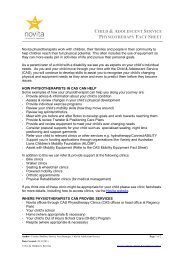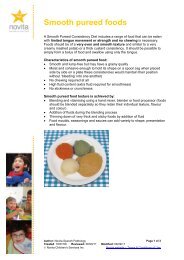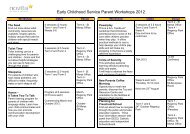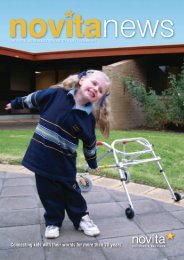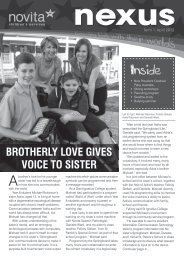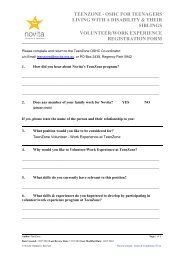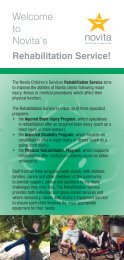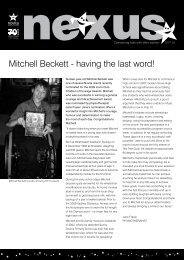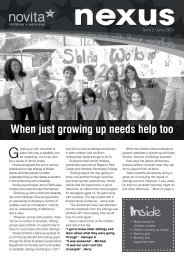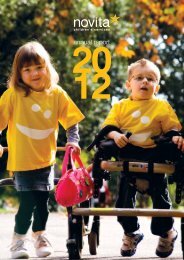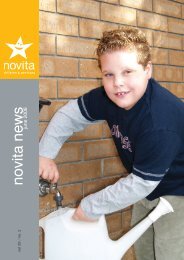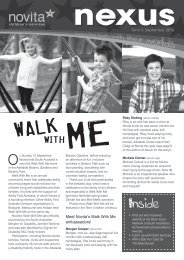Early Communication Ideas - Novita Children's Services
Early Communication Ideas - Novita Children's Services
Early Communication Ideas - Novita Children's Services
You also want an ePaper? Increase the reach of your titles
YUMPU automatically turns print PDFs into web optimized ePapers that Google loves.
INFORMATION FOR PARENTS AND CARERSEARLY COMMUNICATION IDEASGoal Description Examples / <strong>Ideas</strong>Attention andconcentrationEye contactImitationThe child is able tolook at an object oractivity andconcentrate on it -he listens to soundsand turns towardsthem.The child looks atother people andobjects with interestand learns thatgetting a person’seye-contact (gettingthe other person tolook at you) is away of getting theirattention.The child copiesactions, forexample, clappinghands, blowingraspberries andHold brightly coloured toys near him and encourage him to look at and follow the toy.Encourage him child to look at the object for longer by doing interesting things with it.Sometimes selecting a toy that interests your child will help. Children like toys that arebrightly coloured, make noises and feel nice.Try to get the child to look at you during communication and encourage her when she does so.Children love looking at their parents’ faces and love hearing the sounds of their voices. Trygetting your child to concentrate on your face by using happy and bright facial expressions,singing, blowing raspberries, talking and smiling.Some children love imitation games. If she is doing an action, copy it and play games aroundit. For example, if your child is banging her hands on her tray, you can copy and sing‘Everybody banging’.Start off by imitating your child. This helps children understand imitation and increases thechance that in the future, they will imitate you.Author: <strong>Novita</strong> Children’s <strong>Services</strong>-Speech Pathology Page 1 of 3Created: 19/05/06 Reviewed: 25/07/11 Modified: 25/07/2011© <strong>Novita</strong> Children’s <strong>Services</strong><strong>Novita</strong> website- Terms & Conditions of Use
Goal Description Examples / <strong>Ideas</strong>Turn takingObjectpermanenceCause-effectAnticipationeventually makingsounds.The child takesturns by waiting,listening, lookingand doing.The child learnsthat something stillexists even if itcan’t be seen.The childunderstands that ifhe does somethingthere will be aresult.The child learnsabout events andknows when theyare going tohappen.Copy any sounds that he makes with his mouth to encourage him to have another turnOther things to imitate are coughs, laughing, clapping, and kissing.Play games that will involve turn-taking, such as rolling a ball, putting objects in a container,building with blocks.Encourage your child to take turns in games, even if you need to help him to have his turnWhen the child makes a sound, copy it and encourage him to have another turnAlways allow enough time for the child to have a turn - children with disabilities often takelonger to respond, so allow even more time than usualHide a toy under a scarf and gradually show it.Play ‘peek-a-boo’ games with your hands or a scarf – cover your face for a moment then revealit and say ‘boo’ - help the child to remove the scarf from your face, or her own, to play thegame.Hide fun toys behind your back and then slowly reveal them. Talk about what you are doing.For example, ‘Where is the Teddy? Where has he gone……. Here he is!’Help the child to play with toys and show her what happens when she does something - actexcited about what she has done.If a child finds playing with toys a difficult task, ask an occupational therapist for informationabout how to modify the toys.Give your child lots of opportunities to play with toys where, for example, pushing a buttoncreates music.Show the child what you are about to do and talk about what is coming next - young childrenlearn a lot from routines. For example, bathtime, mealtime, dressing, bedtime, playtime.Help the child to learn about routines by doing things the same way each time. If he alwayshears water running before a bath, he may learn that this sound means bath time.If you always show him the car keys before going for a drive - he may learn that seeing thekeys means you are about to go for a drive in the car.Author: <strong>Novita</strong> Children’s <strong>Services</strong>-Speech Pathology Page 2 of 3Created: 19/05/06 Reviewed: 25/07/11 Modified: 25/07/2011<strong>Novita</strong> website- Terms & Conditions of Use© <strong>Novita</strong> Children’s <strong>Services</strong>
Goal Description Examples / <strong>Ideas</strong>ActivecommunicationChoice MakingThe child makeschoices, indicateswhat they want andshows likes anddislikes.A child indicateswhat they want.Sing songs and rhymes that have an exciting ending. For example, ‘this little piggy’ and ‘roundand round the garden’. Your child may learn to anticipate the tickle at the end. You shouldpause before giving the end tickle and observe your child’s reaction (facial expression, bodymovement etc) to see if they can anticipate what will happen next.Hold up objects and encourage your child to choose between them.Let your child know that you understand what he is trying to ‘say’ when he uses gestures,pointing, body language and so on -say what he wants.Notice when your child expresses his likes and dislikes through facial expression, vocalisationsand body movements (for example, by turning away from an object).Children may indicate choice with facial expression (smiling, frowning, crying), actions(pushing toys away or holding them), pointing, reaching for or looking at what they want.To begin with, you may need to present toys to her one at a time and allow her to look, touchand hear the toy then tell you if she likes it or not with facial expression and hand movement.Later she may be able to reach and look at the toy she wants when you hold two up.Disclaimer: This information is of a general nature only and does not constitute advice. <strong>Novita</strong> <strong>Children's</strong> <strong>Services</strong> Inc. makes no representations as to the accuracy,usefulness, suitability or application of the information to a child's particular circumstances. You should seek professional advice before acting or relying on the information.Author: <strong>Novita</strong> Children’s <strong>Services</strong>-Speech Pathology Page 3 of 3Created: 19/05/06 Reviewed: 25/07/11 Modified: 25/07/2011<strong>Novita</strong> website- Terms & Conditions of Use© <strong>Novita</strong> Children’s <strong>Services</strong>



